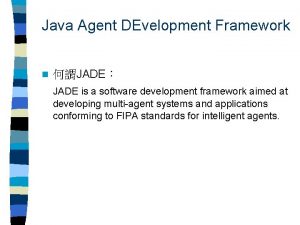Tutorial 4 Using JADE from External Java Applications




- Slides: 4

Tutorial 4 Using JADE from External Java Applications Fuhua Lin, Ph. D, Professor, School of Computing and Information Systems Athabasca University, Alberta, Canada Nov. 7, 2009

In-Process • Since JADE 2. 3, an in-process interface has been implemented in JADE that allows external Java applications to use JADE as a kind of library and to launch the JADE Runtime from within the application itself. • A singleton instance of the JADE Runtime can be obtained via the static method jade. core. Runtime. instance(), it provides two methods to create a JADE main-container or a JADE remote container (i. e. a container that joins to an existing maincontainer forming in this way a distributed agent platform); • both methods requires passing as a parameter a jade. core. Profile object that keeps the configuration options (e. g. the hostname and port number of the main container) required to start the JADE runtime.

• Both these two methods of the Runtime return a wrapper object, belonging to the package jade. wrapper, that wraps the higher-level functionality of the agent containers, such as installing and uninstalling MTPs (Message Transport Protocol)8, killing the container (where just the container is killed while the external application remains alive) and, of course, creating new agents. • The create. New. Agent method of this container wrapper returns as well a wrapper object, which wraps some functionalities of the agent, but still tends to preserve the autonomy of agents. • In particular, the application can control the life-cycle of the Agent but it cannot obtain a direct reference to the Agent object and, as a direct consequence, it cannot perform method calls on that object. Notice that, having created the agent, it still needs to be started via the method start()

A simple way to launch an agent from within an external applications Step 1 Step 2 Step 3 Step 4 Step 5 Step 6







